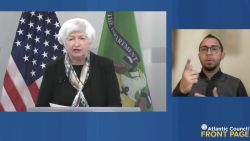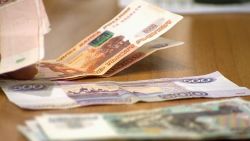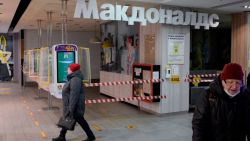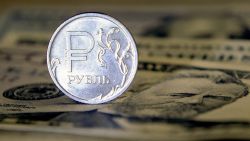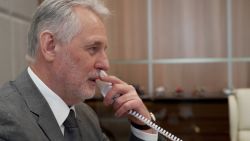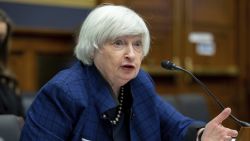Russian President Vladimir Putin has devoted considerable airtime over the past few weeks to reassuring the Russian public that sanctions hurt the West more than they hurt Russia.
Putin is preparing his country for the long haul. “The collective West does not plan on backing off its policy of economic pressure on Russia,” he told aviation executives recently. Every sector of Russia’s economy needs to “make a long-term plan based on internal opportunities.”
Putin’s policy of self-reliance was predictable. Ever since Russia annexed Crimea from Ukraine in 2014, the country has been preparing for increased Western sanctions with a strategy dubbed “Fortress Russia.”
And yet the scale of the economic counter-offensive waged by the West since the invasion of Ukraine on February 24, along with the rising tide of companies cutting off business with Russia to guard against reputational risk or future sanctions, was a shock.
“No one who was predicting what kinds of sanctions the West could bring in could have thought this,” admitted Foreign Minister Sergey Lavrov in March, referring to the freezing of half of Russia’s $600 billion in reserves.
Russia says it will challenge the sanctions on its foreign reserves in court and has also threatened to sue if it is deemed to have defaulted on its debt because of the asset freeze.
Meanwhile, here are some of the ways companies, industries, and officials are scrambling to live with Russia’s new normal.
1. Redesigning the Lada
Russia’s iconic Soviet-era domestic car brand is very reliant on imported parts. Avtovaz, which produces the Lada, is owned by French carmaker Renault, and according to Evgeny Eskov, editor-in-chief of Russian car industry journal Auto Business Review, the companies share a single procurement system for parts.
On March 24, in response to the news that Renault was exiting the Russian market, Avtovaz revealed it was having to quickly redesign several models so they would be less reliant on imported components.

The company did not elaborate on which models would be effected, but said they would gradually become available in the coming months. Eskov said the redesigned models will be simpler versions of current cars, without extra features such as ABS. “Just brutal cars from the past,” he wrote in an email to CNN Business.
2. Luring Instagrammers to Vkontakte
Instagram was — until recently — the top social network in Russia based on monthly users, according to social media analysis firm Brand Analytics. Vkontakte, Russia’s domestic version of Facebook, was second.
Since the invasion, and especially since Russia’s communications regulator cut off access to Facebook and Instagram last month, Vkontakte has been pulling out all the stops to lure content creators over to its platform.
The company is foregoing its commission on any monetized content until the end of April and offering free promotion on the platform for any content creator who has moved from another platform or reactivated their page since March 1. It has also published a step-by-step guide to launching a business on Vkontakte.
Vkontakte’s own data shows this could be working. Monthly users hit a record of over 100 million in March. According to Brand Analytics, Instagram lost almost half of its active Russian-language users between Feb. 24 and April 6.
This is not the whole story, of course. Many Russian Instagrammers are still active on the platform because they can bypass the ban using a VPN. Olga Levakova, who runs a business selling high-end handmade cloth in the style of Tsarist Russia, said that after the initial “shock” and “panic” when Instagram was banned, she continues to use the platform via a VPN to reach her mostly foreign customers.
Levakova considered shutting down after she was inundated with anti-war comments and messages in the first few weeks after the invasion. Those have since died down, but she has removed a line in her page description that mentioned Tsarist Russia. Now it simply says “historical weaving.”
“I just couldn’t take the flood of aggression,” Levakova admits. Orders are still coming in, but she says it’s too early to say whether her business will be impacted.
3. Homegrown credit cards
Russia has been preparing for financial isolation since some of its biggest banks were hit with sanctions after the annexation of Crimea. In some ways, it paid off. Russia’s National Payment Card System and the bank card system built on it, known as “Mir,” have grown exponentially.
According to the Russian central bank, more than 113 million Mir cards were issued in 2021, up from a total of 1.76 million at the end of 2016. Last year, about a quarter of all card payments in Russia were made on Mir cards.
This growth, experts say, was partly engineered by Russia. “They didn’t make it very appealing to ordinary Russians before the invasion,” says Maria Shagina, a visiting senior fellow at the Finnish Institute for International Affairs. Instead the government mandated that public sector employees, pensioners and anyone receiving benefits had to use a Mir card.

That meant that when Visa and Mastercard announced in early March they were suspending transactions and operations in Russia, there was an alternative already in place.
But Mir is not a direct replacement. It only works in Russia and a handful of other countries, mainly former Soviet states.
That lack of global reach also hobbled Russia’s attempt to build an alternative to SWIFT, the international payments system. Its own version, known as SPFS, had 400 participants last year, compared with 11,000 on SWIFT.
“The network effect is not there because foreign participants are not keen on joining it,” Shagina said. “If you don’t trust Russia in other respects why would you trust this system?”
4. Jobs in public works
Mass unemployment, according to Elina Ribakova, deputy chief economist at the Institute for International Finance in Washington, has not appeared yet in Russia, but it is one of the things the Kremlin fears most because of its potential to fuel dissent.
“The more they clamp down on demonstrations, the more I understand that they’re worried about unemployment,” she said. More than 15,000 people were arrested in Russia in the early weeks of the conflict for taking part in anti-war protests, and the Kremlin has effectively silenced independent media by criminalizing what it deems to be “fake information” on its so-called “special military operation.”
The city of Moscow is trying to get ahead of the potential problem of unemployment with a program to retrain and hire people who used to work at Western companies, many of which have suspended or stopped business operations in Russia. Moscow’s Mayor, Sergey Sobyanin, believes up to 200,000 jobs are at risk.
The solution, according to a recent post on his blog, is to give the workers left behind something “useful” to do. The options he outlines include jobs administering official documents like passports and birth certificates, work at one of the city’s parks or at temporary health centers that the city has recently started setting up. $41 million is being set aside to create these jobs and retrain workers.
For Russians who built a career at McKinsey or Goldman Sachs before the war, this would be an abrupt change. But Ribakova said it probably won’t come to that. She believes the majority of executives from foreign companies will leave the country, if they haven’t already.
What next?
Russia has so far managed to withstand the initial force of Western sanctions without its financial system collapsing. That’s largely thanks to the central bank, which immediately raised interest rates to 20% — it has since lowered them to 17% — and imposed strict capital controls.
But this does not mean Russia is through the worst. The economy could shrink by 8.5% this year, according to the IMF. The collapse could be even bigger if Europe bans Russian oil imports. And inflation is at 17.5%, something even Putin admits is hurting Russian citizens.
Another key risk, experts say, is Russia’s reliance on imported products — many of which are now subject to sanctions. Those can be harder for the Kremlin to counter than measures aimed at the macro economy.
“There is a feeling, especially in the government, that they’re going to turn the corner and then there will be a monster,” says Ribakova. “And they just don’t know when exactly that monster is going to eat them up.”

